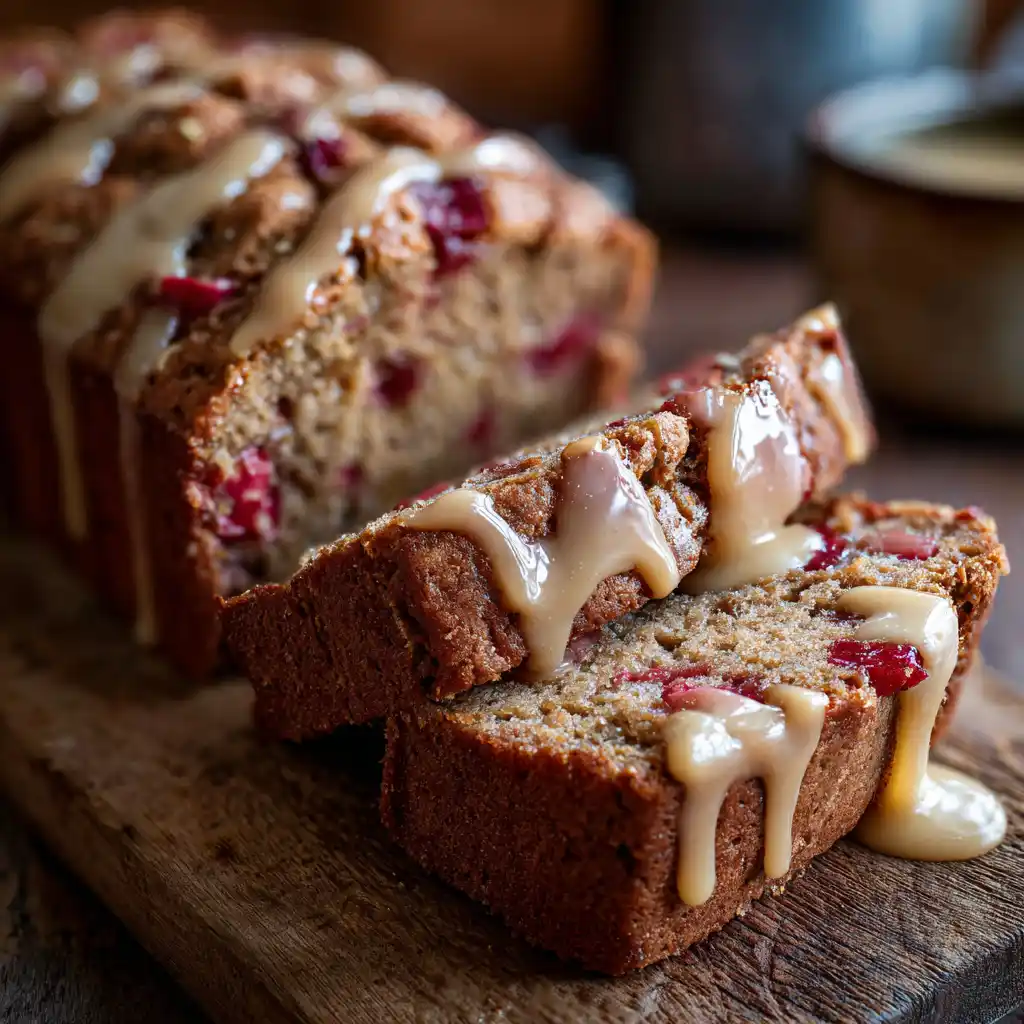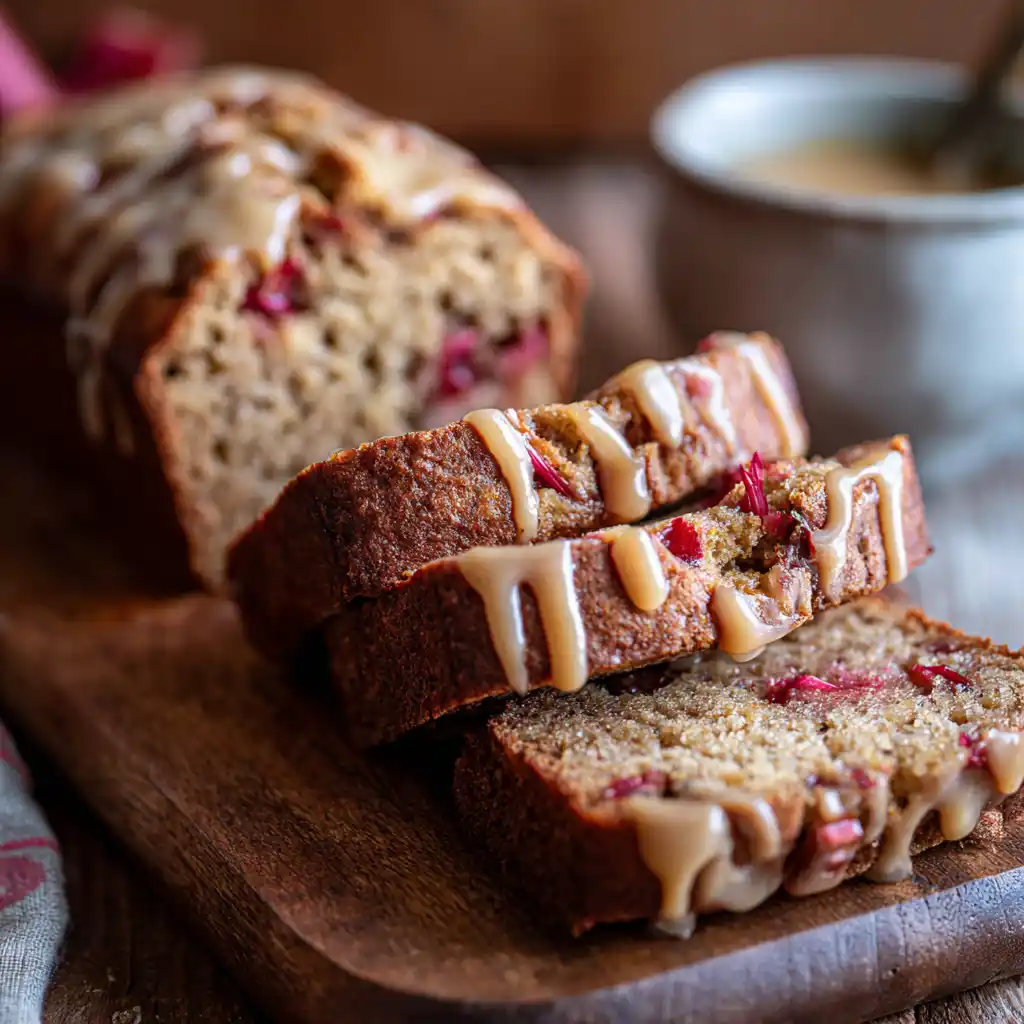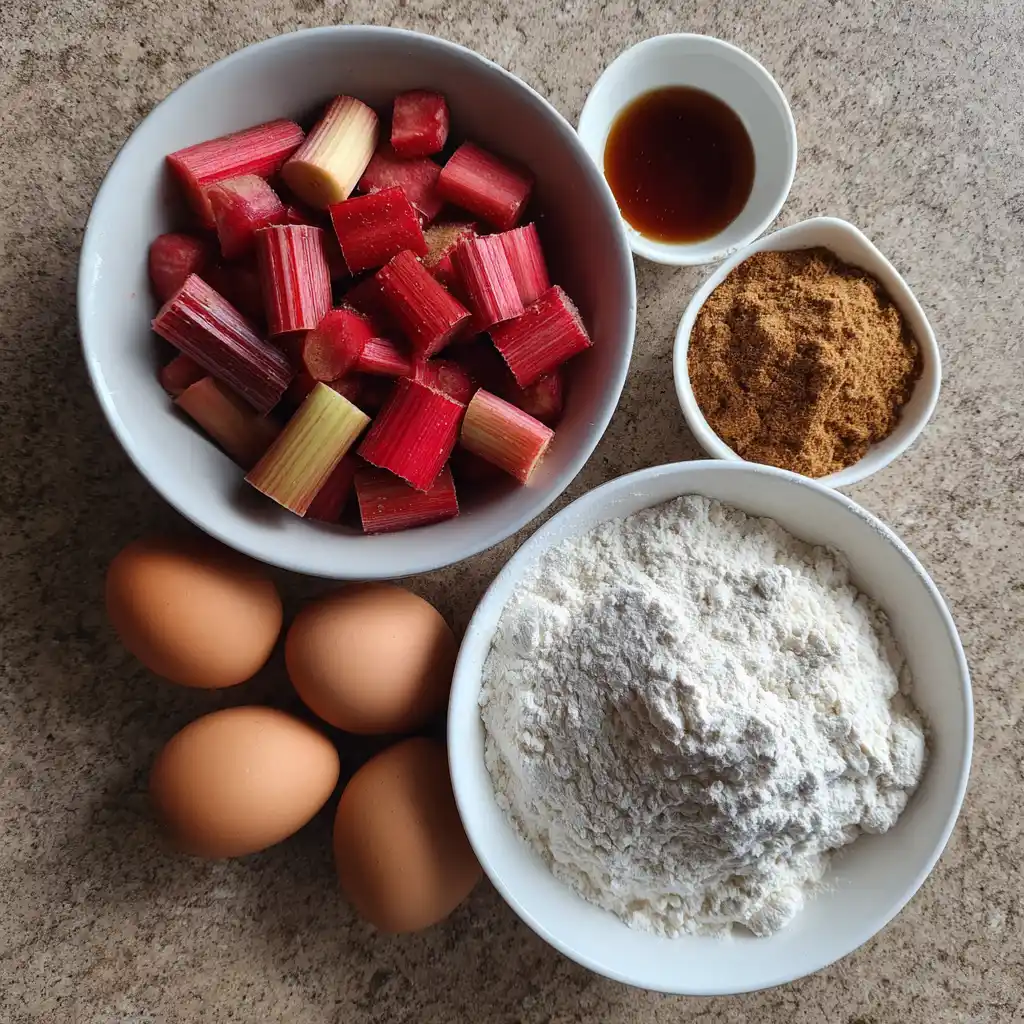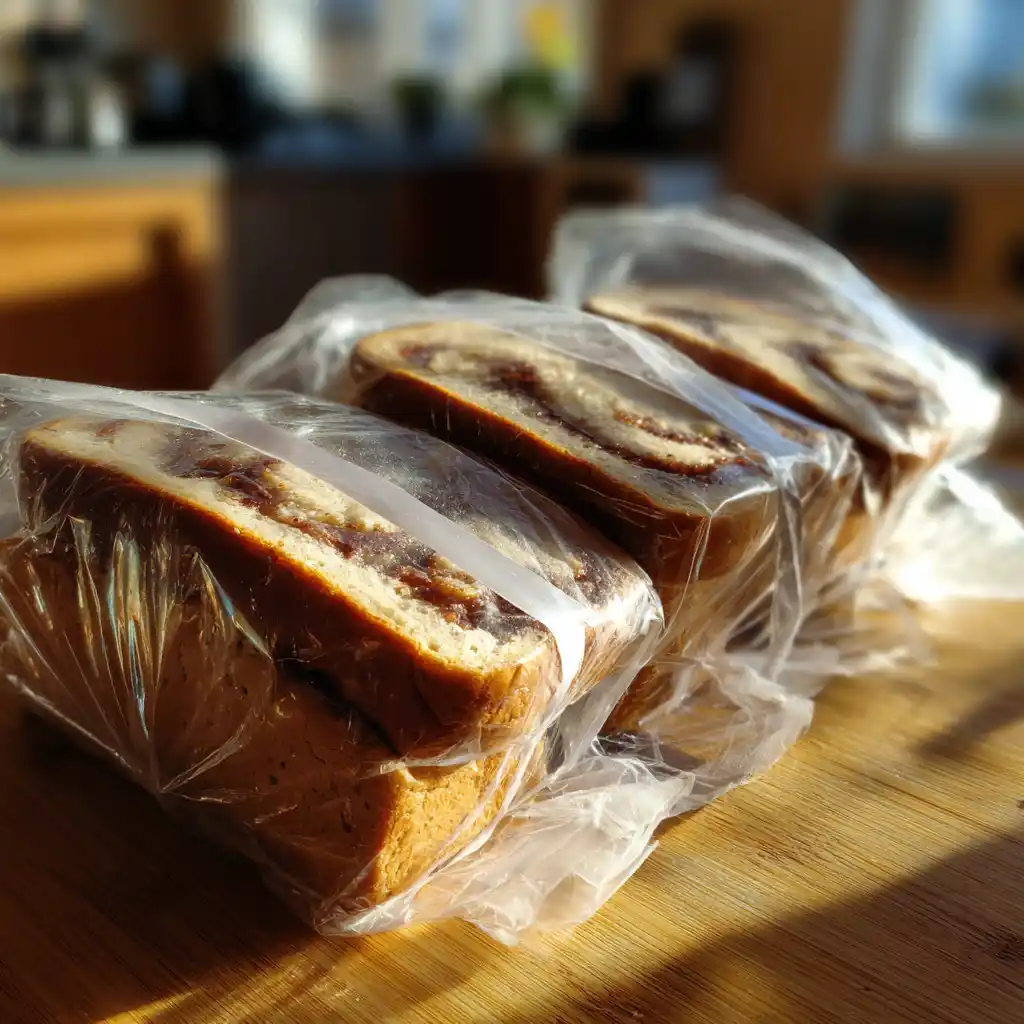
Cinnamon rhubarb bread is one of those magical recipes that feels like home—warm, slightly sweet, and packed with seasonal flavor.
Hi, I’m Maya Sterling. I grew up in Queens, where the stairwell in our building told a story through food—garlic, curry, cinnamon, and more. My parents raised us to believe that meals weren’t just about eating. They were about connecting. Celebrating. Slowing down.
Today, as a trained chef who loves real-life cooking, I create recipes for busy families and home cooks who want bold flavor without the stress. And this cinnamon rhubarb bread? It’s a perfect example.
With fresh rhubarb, cozy cinnamon, and a rich brown-butter glaze, it’s a quick bread that feels indulgent but comes together simply. Whether you’re baking for a brunch, a gift, or just to enjoy a quiet morning slice with coffee, this loaf delivers.
Let’s jump into what makes this recipe a repeat favorite.

Cinnamon Rhubarb Bread with Brown-Butter Glaze
Ingredients
Method
- Preheat oven to 325°F. Lightly grease or spray two 8×4-inch loaf pans and set aside.
- In a large bowl, mix together flour, baking powder, cinnamon, nutmeg, and salt.
- In another bowl, whisk eggs. Stir in sugar, vegetable oil, applesauce, and vanilla extract until well combined.
- Add the wet ingredients to the dry and stir until just combined—do not overmix.
- Fold in the chopped rhubarb, reserving a few pieces for the top.
- Divide batter evenly between pans and press reserved rhubarb pieces into the top of each loaf.
- Bake for 60–65 minutes or until a toothpick inserted comes out clean.
- Cool loaves in pans for 10 minutes, then transfer to wire racks to cool completely.
- For glaze: In a small pan, brown the butter over medium heat (6–8 minutes), then pour into a bowl with sifted powdered sugar. Add vanilla and 1–2 tablespoons half-and-half to reach a pourable consistency. Drizzle over cooled loaves.
Notes
Why Cinnamon Rhubarb Bread Is the Ultimate Summer Bake
The Sweet-Tart Balance That Keeps You Coming Back
Cinnamon rhubarb bread stands out because of its flavor contrast—warm, earthy cinnamon meets rhubarb’s naturally tangy bite. That sharp-sweet combo creates a loaf that’s not too sugary, not too sour, and absolutely perfect for breakfast, dessert, or anything in between.
What makes it special is how the cinnamon enhances the rhubarb’s brightness, mellowing its bite just enough to keep every slice layered and complex. It’s comfort food, yes—but it’s got personality.
Why Quick Breads Like This Beat Traditional Yeast Baking
There’s a reason so many home bakers love quick breads. No rising. No kneading. No stress.
Cinnamon rhubarb bread uses baking powder as a leavening agent, which means you just mix the batter, pour it into the pan, and bake. That’s it. No waiting around, no proving, and definitely no fussing over the perfect rise.
It’s ideal for beginner bakers or busy folks who want a from-scratch recipe without the time commitment of traditional yeast bread. Even better? You can make two loaves in one batch—one for now, one to freeze.
A Seasonal Staple You’ll Bake Again and Again
Rhubarb is in its prime in spring and early summer, making this bread a seasonal must. But thanks to the option of using frozen rhubarb, you can enjoy it year-round—especially if you freeze fresh rhubarb during its peak.
It’s the kind of recipe that earns scribbles in the margins and requests from family and friends. One that smells like summer, tastes like nostalgia, and bakes up in about an hour.
Ingredients That Make This Cinnamon Rhubarb Bread Irresistible

Dry Ingredients That Bring Cinnamon Rhubarb Bread to Life
Every amazing cinnamon rhubarb bread starts with the right dry ingredients. These pantry staples don’t just build structure—they set the stage for flavor.
- All-Purpose Flour (3 cups) – Gives body to the bread and absorbs the moisture from rhubarb and eggs.
- Baking Powder (1 Tbsp.) – Acts fast to give this quick bread its light, fluffy texture.
- Ground Cinnamon (1½ Tbsp.) – The cinnamon flavor is bold and warm, making it a perfect match for the tart rhubarb. It’s the soul of any cinnamon rhubarb bread.
- Nutmeg (¼ tsp.) – A little spice with big impact. It deepens the flavor without overpowering.
- Kosher Salt (1 tsp.) – Enhances sweetness and balances out the tartness of the fruit.
These ingredients combine to give the loaf its familiar, comforting structure and spice-rich base.
Wet Ingredients That Keep Your Loaf Tender and Sweet
What makes cinnamon rhubarb bread truly stand out is its balance of moistness and sweetness. That’s where these wet ingredients shine:
- Large Eggs (3) – These hold everything together while adding richness.
- Granulated Sugar (1½ cups) – Sweetens the bread and helps it brown beautifully.
- Vegetable Oil (¼ cup) – Keeps the crumb tender and soft, even after a few days.
- Applesauce (¼ cup) – Adds subtle fruity notes while reducing the need for extra fat.
- Pure Vanilla Extract (1 Tbsp.) – Elevates the cinnamon and rhubarb combo, giving the bread a bakery-style flavor.
When whisked together, these ingredients make a batter that’s rich, flavorful, and smooth enough to showcase the fruit.
The Star Ingredient: Rhubarb in All Its Tart Glory
What would cinnamon rhubarb bread be without juicy chunks of rhubarb? You’ll need:
- Chopped Rhubarb (2 cups) – Fresh is ideal, but frozen works too (just drain well). Rhubarb melts into the batter during baking, giving each bite a tangy contrast that cuts through the sweetness.
- Reserved Rhubarb Pieces (a few extra) – Press these into the top of each loaf before baking for a beautiful presentation.
Rhubarb is the ingredient that makes this bread seasonal, stunning, and just different enough to feel special.
The Final Touch: Brown-Butter Glaze That Seals the Deal
To make your cinnamon rhubarb bread unforgettable, you’ll want to finish it with this velvety brown-butter glaze:
- Unsalted Butter (4 Tbsp.) – Browned until golden and nutty. Adds richness like no other topping.
- Powdered Sugar (1 cup, sifted) – Forms the base of the glaze for that silky-smooth finish.
- Half-and-Half (1–2 Tbsp.) – Adjusts consistency without thinning the flavor.
- Pure Vanilla Extract (1 tsp.) – Rounds out the glaze with a warm, sweet aroma.
Drizzle the glaze while warm, letting it melt into the bread just slightly. It creates a bakery-worthy crust that elevates every slice.
How to Make the Perfect Cinnamon Rhubarb Bread

Step-by-Step Instructions for Fluffy, Flavor-Packed Bread
Making cinnamon rhubarb bread at home is easier than you might think. With no yeast to worry about, the process is fast and beginner-friendly.
Here’s how to do it:
- Preheat your oven to 325°F. Lightly spray two 8×4-inch loaf pans with nonstick baking spray or lightly oil them, then set aside.
- Mix dry ingredients. In a large bowl, stir together 3 cups flour, 1 tablespoon baking powder, 1½ tablespoons ground cinnamon, ¼ teaspoon nutmeg, and 1 teaspoon kosher salt.
- Prepare the wet mixture. In a separate bowl, whisk 3 large eggs. Stir in 1½ cups sugar, ¼ cup vegetable oil, ¼ cup applesauce, and 1 tablespoon vanilla extract until fully combined.
- Combine wet and dry ingredients. Pour the wet mixture into the dry ingredients. Stir gently just until moistened—don’t overmix or your cinnamon rhubarb bread will turn dense.
- Fold in the rhubarb. Add 2 cups of chopped rhubarb (reserve a few pieces for topping). Gently fold into the batter.
- Pour into loaf pans. Divide the batter evenly between your pans. Press a few extra pieces of rhubarb into the top for a beautiful finish.
- Bake for 60–65 minutes. Insert a wooden toothpick into the center of each loaf—if it comes out clean or with just a few crumbs, your bread is done.
- Cool before glazing. Let the loaves cool in their pans on a wire rack for 10 minutes. Then, remove and cool completely on the rack.
Tips to Avoid Overmixing and Achieve the Perfect Crumb
Quick breads like cinnamon rhubarb bread should have a tender, moist texture—but it’s easy to overwork the batter if you’re not careful.
Here’s how to keep it light:
- Use a rubber spatula or wooden spoon instead of a mixer.
- Stir until just combined. You should still see a few streaks of flour when you fold in the rhubarb.
- Don’t smooth the batter too much in the pan. A little rustic unevenness gives it a better rise and home-baked charm.
Overmixed batter creates a gummy texture and uneven baking, especially in quick breads with fruit like rhubarb.
How to Know When It’s Done—Without Guesswork
Because ovens vary, don’t just trust the clock. Instead:
- Check with a toothpick or cake tester. It should come out mostly clean, not gooey.
- Look for golden edges. Your cinnamon rhubarb bread should pull slightly away from the sides of the pan.
- Test in more than one spot. Rhubarb holds moisture, so it’s smart to test both ends of the loaf.
Once it cools, your bread is ready to glaze, slice, and serve. And trust me—it’ll be hard not to eat a piece right off the rack.
The Science Behind Cinnamon in Bread Recipes
What Cinnamon Does in Bread—More Than Just Flavor
Cinnamon is more than just a cozy spice—it plays a surprising role in the chemistry of baking. In cinnamon rhubarb bread, it does far more than add warmth. It actually interacts with sugars and fats to enhance sweetness, balance acidity (especially important when using tart rhubarb), and improve the overall aroma of the loaf.
When cinnamon is baked, it releases cinnamaldehyde, the compound responsible for that classic cinnamon scent. This not only fills your kitchen with nostalgia—it also triggers a positive sensory reaction that makes baked goods taste richer and more complex.
Cinnamon also has mild antimicrobial properties, which can slightly extend the freshness of your quick breads. So that loaf of cinnamon rhubarb bread you made on Sunday? It’ll still taste just as good on Tuesday.
Does Cinnamon Affect Yeast in Bread? (Not Here, but Good to Know)
While cinnamon rhubarb bread is a quick bread (meaning it rises with baking powder, not yeast), it’s worth understanding how cinnamon affects yeast in other recipes—especially if you’re ever making cinnamon rolls or swirled loaves.
Cinnamon has been shown to inhibit yeast activity when used in high concentrations. That’s why you often see cinnamon added later in yeasted dough recipes, like in swirls or toppings—not mixed directly into the dough.
Luckily, our recipe doesn’t use yeast, so it’s not a concern. The cinnamon gets blended right into the batter, providing even flavor without affecting the rise.
Why Cinnamon and Rhubarb Are a Perfect Pairing
In the world of flavor matching, cinnamon and rhubarb are a power duo. Rhubarb brings sharp, fresh acidity, while cinnamon offers sweet spice and depth. Together, they balance each other beautifully:
- Cinnamon softens rhubarb’s tart edge.
- Rhubarb brightens up cinnamon’s warmth.
- Both are seasonal stars—spring meets early autumn in one loaf.
This is why cinnamon rhubarb bread feels like a comfort food classic but still offers something new. It tastes like a memory you didn’t realize you had.
Rhubarb 101 – Handling This Tangy Gem
What Exactly Is Rhubarb, and Why Use It in Bread?
Rhubarb might look like pink celery, but its flavor couldn’t be more different. It’s a vegetable, though often treated like fruit in baking thanks to its bold, tangy taste. In cinnamon rhubarb bread, rhubarb cuts through the richness and sweetness, adding juicy bursts of brightness to every slice.
It’s also packed with fiber, vitamin K, and antioxidants—so while it’s not a “health bread,” adding rhubarb gives a slight nutritional boost.
Why it works so well:
- Its tartness balances sugar and spice.
- It softens while baking, becoming melt-in-your-mouth tender.
- It keeps the bread moist for days.
How to Prep Rhubarb for Cinnamon Rhubarb Bread
Using rhubarb in bread isn’t hard, but a few prep tips will guarantee the best results:
- Trim the ends and peel away any stringy bits from older stalks.
- Never eat the leaves—they’re toxic due to high levels of oxalic acid.
- Chop into small, uniform pieces—about ½-inch chunks work best to distribute flavor evenly through the bread.
- If using frozen rhubarb, do not thaw—just toss it in straight from the freezer. If you thaw it, it releases too much liquid and can lead to soggy bread.
Fresh rhubarb is best from April to June, but you can often find it in farmers’ markets or grocery freezers year-round.
How to Store Extra Rhubarb (and Make It Last All Year)
If you’ve scored a bunch of rhubarb during its short season, here’s how to keep it ready for your next cinnamon rhubarb bread craving:
- Refrigerate fresh rhubarb in a plastic bag for up to 1 week.
- Freeze chopped rhubarb in a single layer on a baking sheet. Once frozen, transfer to a freezer-safe bag or container.
- Label and date it—frozen rhubarb keeps for 10–12 months.
Freezing your rhubarb means you can whip up this bread in January and still enjoy a taste of spring.
Common Baking Mistakes with Cinnamon Swirl and Rhubarb Bread
Why Your Cinnamon Swirl Might Separate (And How to Fix It)
One of the most common issues when baking cinnamon rhubarb bread is a separated or sunken cinnamon swirl. You go to slice it, and instead of that beautiful ribbon of spice, there’s a gaping hole or a soggy center. Here’s what went wrong—and how to fix it:
Mistake #1: The batter was too wet or under-mixed.
While you should never overmix quick bread batter, under-mixing can cause uneven layering and weak structure. Make sure dry pockets are gone before layering your swirl.
Mistake #2: Cinnamon sugar wasn’t swirled in.
If you’re adding a cinnamon-sugar layer, always swirl it gently with a knife before baking. Leaving it as a thick middle layer can cause it to separate during baking.
Mistake #3: Oven too hot.
An overly hot oven causes the top to rise too quickly, which can push the swirl downward. Stick with the recommended 325°F and don’t skip preheating.
If you’re not adding a swirl but mixing cinnamon directly into the batter (as we do in this recipe), that eliminates this issue completely—and gives you consistent cinnamon flavor in every bite of your cinnamon rhubarb bread.
Preventing Soggy, Dense, or Gummy Rhubarb Bread
Another common issue? Bread that looks done on top but is raw in the middle—or worse, dense and gummy. Here’s how to avoid that:
- Don’t add thawed rhubarb. Use fresh or frozen (unthawed) rhubarb to keep excess moisture out of the batter.
- Check doneness properly. Insert a toothpick into multiple spots—not just the center. Rhubarb pockets can give false “done” readings.
- Let it rest before slicing. Warm bread continues to set as it cools. Cutting too early makes it collapse or stick to the knife.
Bonus Tip: Use Parchment for Easy Removal
Lining your loaf pans with parchment not only helps with clean-up—it also prevents the bottom from sticking, especially if any glaze or rhubarb juice settles. Let the parchment overhang the sides slightly so you can lift the loaf out after cooling.
When done right, cinnamon rhubarb bread should have a moist, tender crumb, a golden crust, and bright bursts of fruit throughout—not a soggy bottom or crumbly mess.
Serving Suggestions and Variations for Cinnamon Rhubarb Bread
How to Serve Cinnamon Rhubarb Bread Any Time of Day
Cinnamon rhubarb bread is incredibly versatile. You can serve it warm, room temp, or even slightly chilled—and it shines in every setting. Whether it’s brunch with friends or a midweek snack, here are my favorite ways to enjoy it:
- Breakfast: Serve a slice warm with a pat of butter or a smear of cream cheese. Add coffee, and you’ve got the perfect start to your day.
- Brunch Board: Slice it thick and arrange on a tray with berries, nuts, yogurt, and soft cheeses.
- Afternoon Snack: Enjoy with tea, lemonade, or almond milk for a quick pick-me-up.
- Dessert: Top with vanilla bean ice cream or whipped cream. The glaze and cinnamon balance out the sweetness beautifully.
It’s not just a loaf—it’s a flexible, flavor-packed bite of comfort.
Tasty Twists on Classic Cinnamon Rhubarb Bread
Once you’ve mastered the original, here are a few fun variations that turn your cinnamon rhubarb bread into something new:
1. Add Chopped Walnuts or Pecans
For a little crunch, stir ½ cup of toasted nuts into the batter or sprinkle some on top of the glaze.
2. Make It Gluten-Free
Swap in a 1:1 gluten-free baking flour mix. Many readers have had success with this, especially when paired with a touch of xanthan gum.
3. Try a Cream Cheese Swirl
Before baking, drop spoonfuls of sweetened cream cheese on top of the batter and swirl lightly with a knife. Bake as usual—just add a few minutes to the time.
4. Streusel Topping Instead of Glaze
Mix 3 tablespoons butter, ¼ cup brown sugar, and ⅓ cup flour with a dash of cinnamon. Crumble over the batter before baking for a crunchy top.
5. Citrus Zing
Add 1 teaspoon of orange or lemon zest to the batter. It’ll brighten the rhubarb flavor and add a fresh layer to the cinnamon’s warmth.
Make It Ahead—And Make It Count
This bread gets better the next day. Once cooled, wrap it tightly in plastic wrap and refrigerate overnight. The flavors mellow, the glaze sets perfectly, and the crumb holds together like a dream.
Warm it slightly before serving, or enjoy it straight from the fridge—it’s just that good.
How to Store and Freeze Cinnamon Rhubarb Bread

How to Store Cinnamon Rhubarb Bread for Maximum Freshness
Once you’ve baked the perfect loaf of cinnamon rhubarb bread, the next step is making sure it stays fresh, moist, and delicious for as long as possible.
Here’s how to store it:
- Room Temperature (Short-Term)
Wrap the cooled loaf tightly in plastic wrap or foil. Keep it at room temperature for up to 3 days. Store it in a bread box or airtight container to prevent it from drying out. - Refrigerator (Medium-Term)
If your kitchen runs warm or you’re not planning to eat it right away, place the wrapped loaf in the refrigerator. This will keep it fresh for up to 5–6 days, though the texture may become slightly firmer. - Avoid Air Exposure
Whether you’re storing it on the counter or in the fridge, the key is to keep the air out. This helps preserve the glaze and keeps the bread soft.
Freezing Cinnamon Rhubarb Bread (Yes, It Freezes Beautifully)
Want to enjoy cinnamon rhubarb bread weeks—or even months—later? Freezing is your best friend.
Here’s how to do it right:
- Let it cool completely. Warm bread traps steam, which leads to freezer burn.
- Wrap it twice. First in plastic wrap, then in aluminum foil or a freezer-safe zip-top bag. This double-layer keeps out moisture and odors.
- Label it. Write the date on the wrap so you remember when it was baked.
- Freeze for up to 3 months.
Beyond that, the texture starts to decline.
To thaw:
- Leave it at room temperature (still wrapped) for several hours.
- For a fresh-baked feel, reheat slices in the toaster oven for 5 minutes or microwave for 20–30 seconds.
Pro Tip: Freeze slices individually so you can grab one when cravings strike—no need to thaw the whole loaf!
Make-Ahead Magic: Glaze After Thawing for Best Results
While you can freeze cinnamon rhubarb bread with the glaze on, it holds up even better if you glaze it after thawing. Simply store the glaze ingredients separately and prepare a fresh batch once the loaf is ready to serve.
It takes just minutes and gives the bread that fresh-from-the-oven finish, even weeks later.
Expert FAQs on Cinnamon Rhubarb Bread (Based on Search Intent)
Is cinnamon good for killing Candida?
Cinnamon may help fight Candida overgrowth thanks to its natural antifungal properties. Research suggests that cinnamaldehyde, the active compound in cinnamon, can inhibit the growth of Candida albicans, the most common yeast responsible for infections like thrush or gut imbalance.
However, while cinnamon may support antifungal efforts as part of a broader anti-Candida diet, it’s not a cure on its own. It works best when paired with other dietary changes—like reducing sugar, processed carbs, and including probiotics.
Important: Always consult a healthcare provider before using cinnamon or any supplement to treat Candida, especially in high doses. Cinnamon is powerful, but it should complement—not replace—professional treatment.
Can I freeze rhubarb bread?
Absolutely. In fact, cinnamon rhubarb bread freezes beautifully. Once completely cooled, wrap the loaf tightly in plastic wrap and then in aluminum foil or a freezer-safe bag. It will keep its moisture and flavor for up to 3 months in the freezer.
When you’re ready to enjoy it, thaw at room temperature while still wrapped to avoid condensation. For a bakery-style bite, warm individual slices in the oven or microwave and drizzle with fresh glaze.
Why does my cinnamon swirl bread separate?
If your cinnamon swirl layer is too thick or not swirled in, it can create a gap inside the bread. Other common causes include:
Overly wet batter
Uneven baking temperature
Not combining layers well before baking
In cinnamon rhubarb bread, we avoid this by blending cinnamon right into the batter, so you get even distribution without any separation issues.
What does cinnamon do in bread?
Cinnamon adds more than just flavor. In cinnamon rhubarb bread, it:
Enhances sweetness without needing extra sugar
Creates a warm, aromatic profile that complements tart rhubarb
Boosts shelf life slightly thanks to its natural antimicrobial properties
Improves aroma during baking, making your kitchen smell incredible
It’s the kind of spice that turns an everyday recipe into something you want to share—or keep all to yourself.
Conclusion: The Bread That Balances Bold Flavor and Simple Joy
Cinnamon rhubarb bread is more than just a seasonal treat—it’s a go-to recipe that’s easy to love, easy to share, and surprisingly easy to make. Whether you’re baking it for weekend brunch, slicing it up for snacks, or freezing a loaf for later, this bread checks every box: warm, moist, tangy, sweet, and beautifully spiced.
It brings together everything I love about real-life cooking—big flavor, minimal fuss, and ingredients that make you feel something. And with its rich brown-butter glaze, it turns any ordinary day into a little celebration.
So if you’re looking for a new favorite loaf that feels like comfort and tastes like magic, give this cinnamon rhubarb bread a try. I promise, it’s the kind of recipe that earns a permanent spot in your rotation.
If you love honest food with heart and crave visual inspiration, join my kitchen community on Facebook and explore seasonal favorites and behind-the-scenes recipes on Pinterest